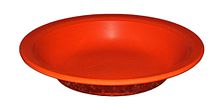
I like a lot of stuff. As in, different things. Pyrex, cookie cutters, books, cookbooks, milk glass, Jadeite, melamine, vintage tablecloths, vintage sheets. Just to name a few. Since I like so many things, I also have a lot of things. I have convinced myself I have collections of things and have them all neatly organized and displayed so as not to appear on an episode of Hoarders.
So when I took the Christmas decorations down I decided to mix it up a bit and showcase some stuff that was stashed away in boxes in the basement. It's kind of like finding a hidden treasure and getting a whole new box of stuff :)
 | ||||||||||||||||||||||||||||||||||||||||||||||||||||||||||||||||
| 95% of my melamine collection |
Melamine resin
From Wikipedia, the free encyclopedia
Melamine resin or melamine formaldehyde (also shortened to melamine) is a hard, thermosetting plastic material made from melamine and formaldehyde by polymerization. In its butylated form, it is dissolved in n-butanol and xylene. It is then used to cross-link with alkyd, epoxy, acrylic, and polyester resins, used in surface coatings. There are many types, varying from very slow to very fast curing.
Applications
In the kitchen
Melamine resin is often used in kitchen utensils and plates (such as
Melmac). Melamine resin utensils and bowls are not microwave safe, as
they absorb the microwave radiation and heat up.[1] As with all thermosetting materials, melamine resin cannot be melted and, therefore, cannot be recycled through melting.
During the late 1950s and 1960s melamine tableware became highly fashionable. Aided crucially by the stylish modern designs of A. H. Woodfull and the Product Design Unit of British Industrial Plastics, it was thought to threaten the dominant position of ceramics
in the market. The tendency of melamine cups and plates to stain and
scratch led sales to decline in the late 1960s, however, and eventually
the material became largely restricted to the camping and nursery market.[2]




